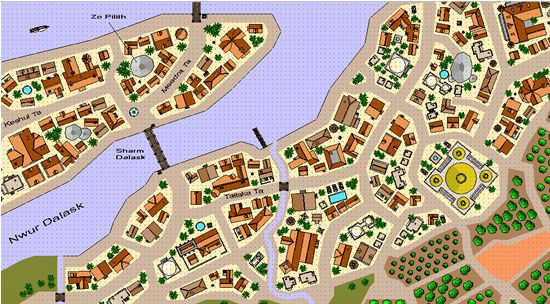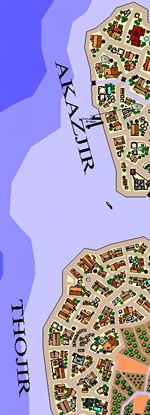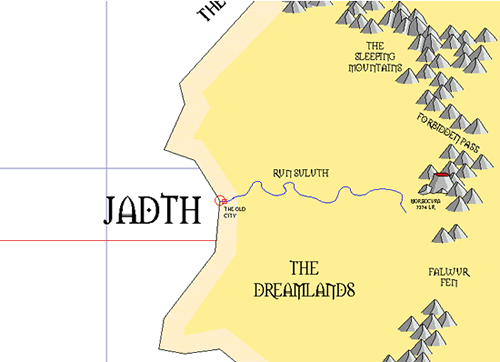|
The World of Teréth End - Gazetteer - Tasserus - Dekàlas |
||||
|
Links Home "...[name] stood in the [name2] Hall, a hundred peers watching from the galleys above. She called her Provider's name, and all could feel the power she commanded. [name3] summoned his wards, but all that watched knew his efforts were in vain. The next name she offered was his, and the misery of [name3] was legend." translated from Dekàlan fragment found in ruins of Ilduùn Jadth Groups Esara'shal
Kdar Jadth People |
Jadth Capital: City of Jadth Nor Kalas Jadth is one of two southern city-states of the Old Empire Dekàlas that lies on the continent of Tasserus. The southern-most city-state of Dekàlas, the City of Jadth is built upon the delta islands of the ponderous Run Suluth. The region around the City of Jadth is surrounded by a thick veil known as the Dreaming Ring.

Introduction "The first time I came to Jadth I smelled the City before it came into view through the evening haze. The sun was setting behind us as the galley-men rowed us into port, the sound of the oars soon fading into the sounds of the bustling docks. Ships with sails of all colors were moored there. Endless chains of men and beasts unloaded exotic wares from the ships and loaded cloth, casks, and crates back on board. "As we drew closer the crew grew more nervous. This was the first truth that I learned of the City; visitors cannot wait to leave but natives remain relaxed and calm. A lethargy hangs over the City that crouches on the edge of the Dreamlands. Though the Temple of Sudul stands abandoned in the Old Quarter his heavy presence is breathed with every step. "The second thing I noticed about the City were the high vine shrouded stones. The Jadthari call them pilith, and they tower above all the buildings and wooden walkways like sentinels of Woad. Many support spiraling walkways and over-reaching platform houses; most near the Sha'al neighborhoods others are left in their natural state. The Sha'al do however cover their bases with intricate reliefs, some of which are worn beyond recognition and older than the surrounding City. "As our ship moved into the City through the Run Suluth delta I was struck by the variety of the people that mill through the streets, and the intermingled architectures borrowed from homelands far more distant than I've traveled. The piers were filled with the expressionless dull-violet Nuth, a slave-race found deep within the Dreamland jungles. All stopped for a moment to watch our ship pass, but were whipped back to duty. There was no outwardly obvious pain or recoiling from the whips, but they continued working just the same. "Passing between the pier-lined shores, I watched the dweme pass slowly by. Their covered tables were packed with throngs of patrons, sipping tropical drinks and smoking from elaborate pipes and bowls. Some stared mindlessly into the turning brown river water, others into the hazy sunset clouds. Somewhere ahead, a torru cried; I spent a minute or so scanning the docks for the "imperiled lady" before it was explained to me. "I spent the next several minutes searching the water for sight of the fish. I could not find anything resembling the description, but did notice hundreds of little whirlpools and regions where the water bubbled furiously. One of the sailors pointed and explained which were springs, and which were radu. I could not tell the difference, but her identification indicated that the differences were "obvious". It occurred to me that swimming might be unthinkably dangerous here. "At the dock a tall man climbed on to the ship and spoke with the captain for several minutes. During this the sailors climbed the rigging and furled the large lanteen sail. I heard the anchor chain slide through a channel beneath the deck, and was surprised at how long it fed before stopping. The Run Suluth cuts a deep channel through Jadth. Waiting on the docks were five Nuth waiting for instruction. "Finally, the tall man climbed back to the dock and after giving the slaves their orders walked down the shore to another pier, where a dark blue ship was mooring. The captain found me among the ensuing bustle and shook my hand. "Welcome to the Dreaming City" he said. "We'll be leaving in the morning but your passage ends here so as long as you and your belongings are off-ship by dawn, our business is done. Good luck." I thanked him for an uncomplicated journey and went below to gather my things. "Soon I was stepping from the ship that had been my home these past couple months, unsure what to expect and hoping that I would meet my contacts before too long here, alone. Lures of the Calasba Ta "Following your nose is a dangerous way to orient one's self. No street names are painted on the buildings of Jadth and except for the occasional obelisk one street is very like another. For an hour or more I wandered in and out of streets and alleys, attracting curious and unwelcoming looks. I asked several people for directions, and although most seemed to know what I was saying, I could not begin to understand the answers. I had been warned about this before setting-out for Jadth, that the City was a mixing bowl of people, races, cultures, and languages. I admit to stopping and watching the strange Sha'al as they moved effortlessly and unconcerned among the Uren. "A similar scene in Candal would have incited a ...
Built on marshy delta lands, the City of Jadth has four main divisions: North Bank, South Bank, the Islands, and the Old City. North Bank The mercantile North Bank of Jadth extends along the shore from the Bay of Jarjat to the Odho borough of Orodh. Many of the city's wealthiest neighborhoods lie along the North Bank, as well as the Jadthari Palace, home to the ruling High family. Little known to the population of the City of Jadth, is that deep into the High family's demesne lies the Mound of Izzaradragulth. South Bank The residential South Bank of Jadth extending along the shore from the Bay of Jarjat to the ... Akazjir. A southerly borough of Jadth, Akazjir is home to the Carnelian Tower and the the Hall of the Red Knights. Less notably but of some increasing importance is the home of Zuroolly Hicubaba on the borough's eastern swampy edge. Thojir. A lower class neighborhood that is home to many community bazaars, some of which are active long into Nightsdeep. Many laborers within the City come to Thojir to be hired to work the fields. The Islands Scattered about within the mouth of the Run Suluth are a dozen islands reinforced by stone sea-walls ages past. Perched atop the river islands stand the brightest and best houses of the City. The islands are connected by a network of wooden bridges arching across the dark green nwure. Though covered with vines and river-life, the sea-wall stones are giant and ancient, placed by ancient people or things. The Old City Sitting atop high vine-conquered plateau (Hor Jordol) sits the ruins of the Old City. Horrible faces and odd images peek through the vegetation of the plateau walls. Dark passages into the plateau's heart stare out across New City below. The residents there speak of those who climbed up to the windows, and never returned. The builders of the Old City is not known, but most is believed to be of pre-Dekàlan construction. The Bowls were a later addition to the area, erected for the priesthood of Sudul. Within the plateau of Hor Jordol are countless tunnels and forgotten chambers, sealed by priests of Sudul when the Dekàlans came to this place. The priests claim that the old ways were sealed to prevent that which lives within Hor Jordol from getting out. That is probably at best a partial truth. Many of the ancient places and secrets within Hor Jordol speak of a time before the coming of Uren to this region and is therefore a point of contention between the Sha'al and Uren of the Dreamlands. The thieves of Jadth seem to be constantly discovering new entrances into the forgotten corridors. Some have taken refuge within the Hor Jordol, but most are never seen again. Landmarks The Bowls are a set of mammoth stone bowls that sit at the top center of Hor Jordol, the Old City. The Bowls are believed to have been constructed in the early years of the Dekàlan conquest. It is unknown how the objects were brought to their resting place as each piece is massive and appears hewn from a single stone. The interlocking of the bowls is masterfully carved leading some to believe that the sculpture was either engineered by Dwürden of the Sleeping Mountains, or perhaps even divinely inspired. The foremost (westerly) bowl collapsed Dekàlan History The colony of Ava Tereth was founded in 92 HK (over 100 years before the founding of Jadth) by Lanadan explorer Olluk Peraram. The earliest buildings were constructed by white Sha'al who had been furnished for the purpose of erecting an Uren embassy south of the Run Suluth. When word returned to Lanàdus that Peraram had made peaceful contact with the Sha'al, an ambassador and his cohorts arrived in 95 HK to exchange gifts and discuss terms for establishing a small Dekàlan colony. By 98 HK, a small colony had emerged between the embassy and the mouth of the Run Suluth. The colonists arrived quickly, criminals and settlers shipped from turbulent Azàlari. Inevitable land right disputes triggered skirmishes along the colony borders. The Sha'al were perplexed by the "civilized" Uren and their cavalier disregard to established pacts. In 105 HK, nearly three dozen settlers were found slaughtered at their borderland farms. The colony magistrate blamed the Sha'al which claimed no responsibility for the murders. In the 106 HK the first Dekàlan troops arrived at Ava Tereth (new land). Skirmishes continued for little more than a year before the Sha'al ceded the region to Dekàlan rule. Another pact was signed granting a larger area, still shy of the Run Suluth. The magistrate arranged marriages between the indigenous Uren and the colonists, securing ties with the Uren of the region. In 113 HK the High King turned his attention finally to Ava Tereth, seeking to carve a new resource-rich city-state on the continent Tasserus. Twenty galleys plied their way from Azàlari and Lanàdus toward the colony. The magistrate of Ava Tereth explained to the war generals that the most valuable land in the Dreamlands was the mouth of the Run Suluth. There an ancient city stood that was sacred to the Sha'al. Rather than attack the city out-right, the generals turned their attentions south of the colony, seeking to cut-off the Dreamlands Sha'al from their homelands in the Vast Untamed. The resulting conflict lasted over 80 years. Though the Dekàlans had extended and secured their southern border, their numbers and resources were spent.
In 194 HK, the High King sent hundreds of small galleys filled with Azàlari and Sharran warrior slaves to the Run Suluth. Untrained and poorly equipped, the warriors fought hard for their freedom but most were slaughtered horribly. The battle bought the Dekàlan army three days' time to reach the river. Within sight of the ancient city the army rested an additional day as scouts returned with news of the slaughter. On the fourth day, the army marched into the city and killed all the Sha'al that did not flee into the forests. Post-Dekàlan History Architecture There are many different constructions and styles of buildings within the City. Most structures are of Dekàlan design and origin, not dissimilar from the Eoyn-influenced architecture found in southern Ildûn. The Eun style is recognizable by its half-timber frame construction with the addition of heavy and sometimes quite elaborate, eaves. Within Jadth, the houses are mortared with a tabby cement made from crushed river shells. Most large houses incorporate Sha'al adaptations like upper-story breeze-throughs. The roofs of Eun houses are not thatched like their northern ancestors, but lined with pressed-leaf shingles, a technique learned from the Sha'al (though not used on their buildings). The Sha'al building style has not changed in a thousand years. Ancient Sha'al dwellings are commonly found buried throughout the southern coast of the Dreamlands that look much the same as residences today. The industrious Sha'al fashion and fire clay bricks for their buildings, covering the finished walls with plaster. Domes are commonly used, Commonly, the interiors are elaborately painted to serve as shrines to their many gods. Cleanliness is important to the Sha'al. Weekly, they can be found scrubbing their homes to keep the encroaching plants and molds from their pristine walls, or the horch nuts from piling on their roofs. Odhoro building is more primitive than either Dekàlan or Sha'al building. Odhoro structures are mostly round huts built using upright trees, ribbed with wooden hoops, and bound together at a peak. The houses are covered with woven reed sheets which are then plastered with mud and clay. The huts are typically one-room buildings with a fire-pit in the center. The finished buildings are painted white and covered with colorful illustrations and family designs. Wealthier Odho chain many of the round houses together to achieve a multi-roomed structure. Most Odho houses are built in family groups. Larger families consist of many concentric circles of houses. There are few Odho circle-settlements within the City of Jadth.
|
Places Akazjir Dekàlan Lands Azàlari
(of Zalan) Tasseri Lands Balaal Information Seawalls: The island sea-walls are fashioned from carved megaliths, also found in the Old City. The wonderfully carved stones of the Old City suggest how the seawalls might have once been ornamented. The Sha'al are particularly concerned with the state of the seawalls, even in areas unfriendly to them. |
||
|
Ref. PHB (Player's Handbook), © Wizards of the Coast  |
||||
 Regions
Regions